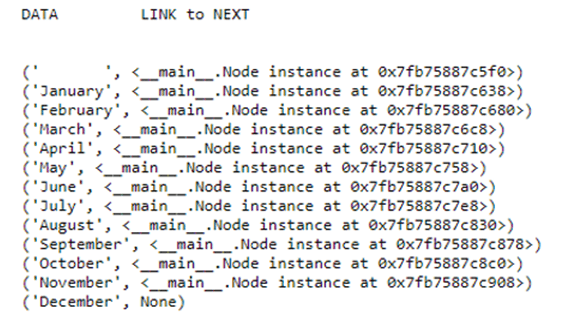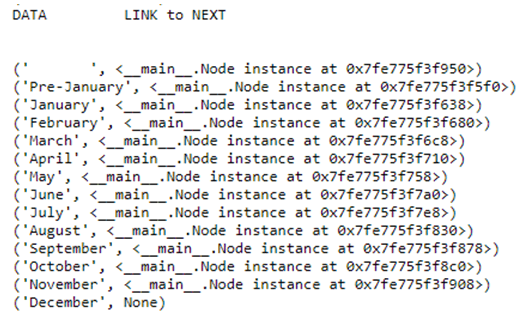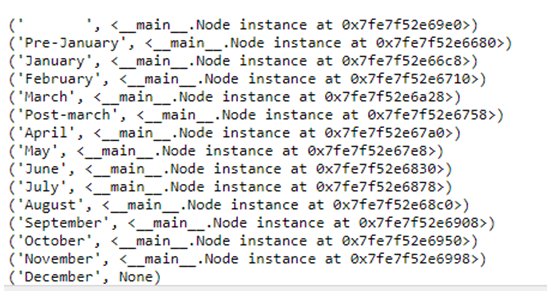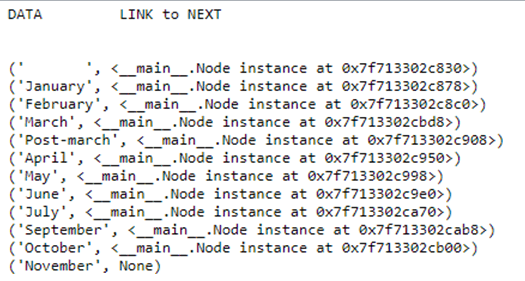Singly Linked List (SLL)
Agenda:
- What is a Node?
- Defining a Node
- Singly Linked List
- Operations on Singly Linked List
- Data
- Next
c. Next Pointer: It stores the memory address (reference) of the next node in the sequence.
d. Head and Tail: The linked list is accessed through the head node, which points to the first node in the list. The last node in the list points to NULL indicating the end of the list. This node is known as the tail node.
- Head and Start both are same.
- Tail and End both are same.
only one direction from head to the last node (tail).
- Traversal - To access each element of the linked list.
- Insertion - To add/insert a new node to the list.
- Deletion - To remove an existing node from the list.
- Search - To find a node in the list.
- Sort - To sort the nodes.
Traversal of Singly Linked List in Python:
# Python Program for traversal of Singly Linked list
class Node:
def __init__(self, data):
self.data = data
self.next = None
def insert_at_beginning(head, data):
new_node = Node(data)
new_node.next = head
return new_node
def traverse(head):
current = head
while current:
# Print the current node's data followed by an arrow and space
print(str(current.data) + " -> ", end=" ")
current = current.next
# At the end of the list, print None to indicate no further nodes
print("None")
# Singly linked list created and its head stored in a variable named "head"
head = None
head = insert_at_beginning(head, 4)
head = insert_at_beginning(head, 3)
head = insert_at_beginning(head, 2)
head = insert_at_beginning(head, 1)
# To traverse and print the nodes:
traverse(head)1 -> 2 -> 3 -> 4 -> NoneInsertion of Singly Linked List in Python:
Given a Linked List, the task is to insert a new node in this given Linked List at the following positions:
- At the front of the linked list
- After a given node.
- At the end of the linked list.
a. Insertion at the Beginning of the linked list:
To insert a node at the beginning of a singly linked list in Python, you need to follow these steps:
- Create a new node with the given data.
- Set the “next” pointer of the new node to point to the current head of the list.
- Update the head of the list to point to the new node.
Below is the implementation of the above idea:
# Python Program for the insertion of node at the beginning
class Node:
def __init__(self, data):
# Initialize a new Node with data and next pointer
self.data = data
self.next = None
def insert_at_beginning(head, data):
# Insert a new node at the beginning of the linked list
new_node = Node(data)
new_node.next = head
return new_node
def traverse(head):
# Traverse the linked list and print its elements
current = head
while current:
print(current.data, end=" -> ")
current = current.next
print("None")
# Driver Code
head = None
head = insert_at_beginning(head, 4)
head = insert_at_beginning(head, 3)
head = insert_at_beginning(head, 2)
head = insert_at_beginning(head, 1)
traverse(head)1 -> 2 -> 3 -> 4 -> Noneb. Insertion after a given node:
To insert a node after a given node in a singly linked list in Python, you need to follow these steps:
- Create a new node with the given data.
- Set the “next” pointer of the new node to point to the next node of the given node.
- Update the “next” pointer of the given node to point to the new node.
Below is the implementation of the above idea:
# Python Program for Insertion after a given node
class Node:
def __init__(self, data):
# Initialize a new node with data and next pointer
self.data = data
self.next = None
def insert_at_beginning(head, data):
# Insert a new node at the beginning of the linked list
new_node = Node(data)
new_node.next = head
return new_node
def insert_after_node(node, data):
# Insert a new node with given data after the specified node
if node is None:
print("Error: The given node is None")
return
new_node = Node(data)
new_node.next = node.next
node.next = new_node
def traverse(head):
# Traverse the linked list and print its elements
current = head
while current:
print(current.data, end=" -> ")
current = current.next
print("None")
# Driver Code
head = None
head = insert_at_beginning(head, 4)
head = insert_at_beginning(head, 3)
head = insert_at_beginning(head, 1)
# Insert 2 after the node with data 1
insert_after_node(head, 2)
# Traverse and print the nodes after insertion
traverse(head) Output1 -> 2 -> 3 -> 4 -> None
c. Insertion at the end of the linked list:
To insert a node at the end of a singly linked list in Python, you need to follow these steps:
- Create a new node with the given data.
- Traverse the list to find the last node.
- Set the “next” pointer of the last node to point to the new node.
Below is the implementation of the above idea:
# Python Program for the insertion at the end of the Singly Linked List
class Node:
def __init__(self, data):
# Initialize a new node with data and next pointer
self.data = data
self.next = None
def insert_at_beginning(head, data):
# Insert a new node at the beginning of the linked list
new_node = Node(data)
new_node.next = head
return new_node
def insert_at_end(head, data):
# Insert a new node with given data at the end of the linked list
new_node = Node(data)
if head is None:
return new_node
current = head
while current.next:
current = current.next
current.next = new_node
return head
def traverse(head):
# Traverse the linked list and print its elements
current = head
while current:
print(current.data, end=" -> ")
current = current.next
print("None")
# Driver Code
head = None
head = insert_at_beginning(head, 3)
head = insert_at_beginning(head, 2)
head = insert_at_beginning(head, 1)
# Insert 4 at the end
insert_at_end(head, 4)
# Traverse and print the nodes after insertion
traverse(head)1 -> 2 -> 3 -> 4 -> NoneDeletion of Singly Linked List in Python:
You can delete an element in a list from:
- Beginning
- After a given node
- End
a. Deletion from the beginning:
To delete a node from the beginning of a singly linked list in Python, you need to follow these steps:
- If the list is empty (head is None), there is nothing to delete.
- Update the head of the list to point to the next node (if any).
Below is the implementation of the above idea:
# Python Program for the deletion of a node at the beginning
class Node:
def __init__(self, data):
# Initialize a new node with data and next pointer
self.data = data
self.next = None
def insert_at_beginning(head, data):
# Insert a new node at the beginning of the linked list
new_node = Node(data)
new_node.next = head
return new_node
def delete_at_beginning(head):
# Delete the node at the beginning of the linked list
if head is None:
print("Error: Singly linked list is empty")
return None
new_head = head.next
del head
return new_head
def traverse(head):
# Traverse the linked list and print its elements
current = head
while current:
print(current.data, end=" -> ")
current = current.next
print("None")
# Driver Code
head = None
head = insert_at_beginning(head, 4)
head = insert_at_beginning(head, 3)
head = insert_at_beginning(head, 2)
head = insert_at_beginning(head, 1)
# Delete the node at the beginning (node with data 1)
head = delete_at_beginning(head)
# Traverse and print the nodes after deletion
traverse(head)2 -> 3 -> 4 -> Noneb. Deletion after a given node:
To delete a node after a given node in a singly linked list in Python, you need to follow these steps:
- Check if the given node is None or if the next node of the given node is None (i.e., no node exists after the given node).
- If either condition is true, print an error message or return since there’s nothing to delete.
- Otherwise, update the “next” pointer of the given node to skip the next node.
- Optionally, free the memory allocated to the deleted node.
Below is the implementation of the above idea:
# Python Program of deletion form a given node
class Node:
def __init__(self, data):
# Initialize a new node with data and next pointer
self.data = data
self.next = None
def insert_at_beginning(head, data):
# Insert a new node at the beginning of the linked list
new_node = Node(data)
new_node.next = head
return new_node
def delete_after_node(node):
# Delete the node after the given node
if node is None or node.next is None:
print("Error: The given node is None or the next node is None")
return
next_node = node.next
node.next = next_node.next
del next_node
def traverse(head):
# Traverse the linked list and print its elements
current = head
while current:
print(current.data, end=" -> ")
current = current.next
print("None")
# Driver Code
head = None
head = insert_at_beginning(head, 4)
head = insert_at_beginning(head, 3)
head = insert_at_beginning(head, 2)
head = insert_at_beginning(head, 1)
# Delete the node after the node with data 3
delete_after_node(head.next)
# Traverse and print the nodes after deletion
traverse(head)1 -> 2 -> 4 -> Nonec. Deletion at the end:
To delete a node at the end of a singly linked list in Python, you need to follow these steps:
- Check if the list is empty (head is None) or if the list has only one node (i.e., head.next is None). If either condition is true, there is nothing to delete.
- Traverse the list to find the second-to-last node.
- Set the “next” pointer of the second-to-last node to None to remove the last node.
- Optionally, free the memory allocated to the deleted node.
Below is the implementation of the above idea:
# Python Program for deletion at the End of Singly Linked List
class Node:
def __init__(self, data):
# Initialize a new node with data and next pointer
self.data = data
self.next = None
def insert_at_beginning(head, data):
# Insert a new node at the beginning of the linked list
new_node = Node(data)
new_node.next = head
return new_node
def delete_at_end(head):
# Delete the last node of the linked list
if head is None or head.next is None:
print("Error: Singly linked list is empty or has only one node")
return None
current = head
while current.next.next:
current = current.next
del_node = current.next
current.next = None
del del_node
return head
def traverse(head):
# Traverse the linked list and print its elements
current = head
while current:
print(current.data, end=" -> ")
current = current.next
print("None")
# Driver Code
head = None
head = insert_at_beginning(head, 4)
head = insert_at_beginning(head, 3)
head = insert_at_beginning(head, 2)
head = insert_at_beginning(head, 1)
# Delete the last node (node with data 4)
head = delete_at_end(head)
# Traverse and print the nodes after deletion
traverse(head)1 -> 2 -> 3 -> NoneSearching of Singly Linked List in Python:
i. Node creation
A program class to create a node should be defined as a first step in the python program and the data objects can be created as when required.
Code:
# Linked list Concepts - Demo Program
class Node:
def __init__(self, item=None, next=None)
self.item=item
self.next=nextii. Linked List Creation
Another program class to create linked list with initial values should be defined in the program as next step. This class would contain steps for subsequent operations like Inserting, Delete, Traverse (Navigation).
Code:
class LinkedListdemo:
def __init__(self, start=None): #Linked list creation
self.start = start #Link to first nodeiii. Initial Data Loading (Insert at The End)
Ideally the initial loading can happen from the end of the empty data set. While inserting a new data, If the dataset is empty make the new node as the first and last node and exit. If data is present in the dataset then navigate to end, make the current last node as last but one node. New node will be the last.
Code:
def insert_at_last(self, data):
new_node = Node(data) # move data
if self.start is None: # empty set
self.start_node = new_node
return
n = self.start
while n.next is not None:
n= n.next
n.next = new_node; #new node is the last
#old last is last but oneiv. Navigating through data set
While navigating check whether the list is empty or not. Use the start node link to reach first node and use the link present in the first node to reach second and move on till the end
Code:
def navigate_list(self): if self.start_node is None: # if there is no first node print("List has no element") #it is empty list return else: print ("DATA LINK to NEXT") # Header print ("\n") # blank line print (" ", self.start) # Link to first node n = self.start # start from first while n is not None: print(n.item , n.next) # Print Data and next link n = n.next # loop iteration
v. Appending Nodes to Dataset
With all definitions are over, create a working object for linked list creation module and invoke it for inserting new nodes at the end.
Code:
new_linked_listdemo = LinkedListdemo() # new object
new_linked_listdemo.insert_at_last("January") # inserting nodes at end
new_linked_listdemo.insert_at_last("February")
new_linked_listdemo.insert_at_last("March")
new_linked_listdemo.insert_at_last("April")
new_linked_listdemo.insert_at_last("May")
new_linked_listdemo.insert_at_last("June")
new_linked_listdemo.insert_at_last("July")
new_linked_listdemo.insert_at_last("August")
new_linked_listdemo.insert_at_last("September")
new_linked_listdemo.insert_at_last("October")
new_linked_listdemo.insert_at_last("November")
new_linked_listdemo.insert_at_last("December")vi. List Dataset
Using the same linked list creation object class, scan through the dataset and view it.
Code:
new_linked_listdemo.navigate_list() # traversing the listOutput:

vii. Insert in The Beginning
Make the new node as the starting node and the existing starting node as the second node. Code:
def insert_at_beginning(iab, data):
new_node = Node(data) # move data
new_node.next = self.start_node # Current first as second
self.start_node= new_node # new as latest first
new_linked_listdemo.insert_at_beginning("Pre-January")
new_linked_listdemo.navigate_list() # traverssing the listOutput:

viii. Insert Next to An Existing Item
Reach the existing item, make it as previous node for the new node. Make the new node as previous node to the next node.
Code:
def insert_nextto_item(self, x, data):
n = self.start_node
while n is not None:
if n.item == x: # match the item
break
n = n.next
if n is None: # no match
print("item not in the list")
else:
new_node = Node(data)
new_node.next = n.next # Swap new node address and previous
n.next = new_node # node linkix. Inserting Node After an Existing Node
new_linked_listdemo.insert_nextto_item("March","Post-march")
new_linked_listdemo.navigate_list() # traverssing the listOutput:

x. Deletion of Nodes
First Node – Make the second node as the starting node Last Node – Reach the last but one node and blank out the next link Any Middle node identified by content – Reach that node and change the link of the previous node to point to next node with reference to node to be deleted.
Code:
def delete_at_beginning(self):
if self.start_node is None: # Empty list
print("Empty List")
return
self.start_node = self.start_node.next # make second node as initial
def delete_at_last(self):
if self.start_node is None:
print("Empty list")
return
n = self.start_node
while n.next.next is not None: # Search last but one node
n = n.next
n.next = None # blank out the link
def delete_element_by_content(self, x):
n = self.start_node
while n.next is not None:
if n.next.item == x: # match found
break
n = n.next
if n.next is None:
print("no such item")
else:
n.next = n.next.next # change previous node link with nextxi. Test the Delete Function
Code:
new_linked_listdemo.delete_at_beginning()
new_linked_listdemo.delete_at_last()
new_linked_listdemo.delete_element_by_content("August")
new_linked_listdemo.navigate_list() # traverssing the listOutput:

.png)





No comments:
Post a Comment